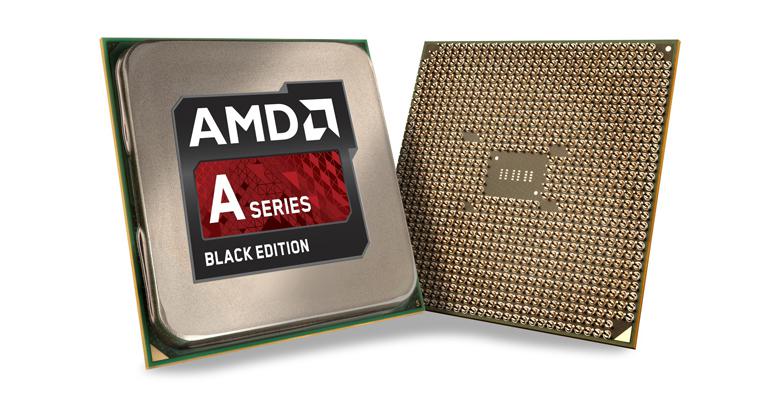Early last year, AMD announced the refresh of the surprisingly impressive Kaveri APUs, the company’s all-in-one solution for the generalist PC user. We managed to get our hands on the second-in-line A8-7670K and put it through its paces to find out if AMD’s CPU-GPU in a chip can still hold the fort on its own without the help of a beefy graphics card.
Specifications:
CPU Cores: Quad-core Steamroller (Two physical cores, four threads)
CPU Clock: 3.6GHz, turbo up to 3.9GHz
Integrated Graphics: Hexa-core AMD Radeon R7
GPU Clock: 757MHz
L2 Cache: 4MB
Socket: FM2+
TDP: 95W
Features: AMD FreeSync, Virtual Super Resolution, AMD Dual Graphics compatible, unlocked multiplier
Design: 4/5
Our review unit of the AMD A8-7670K came in a plain white box, but rest assured commercial units will arrive in the proper packaging, with the stock AMD heat sink, manuals, stickers, and everything else.
Etched on its silver lid is the AMD A8-7000 series marque along with a few other technical details almost nobody would be interested in. On its underside are 906 gold contact pins designed to fit FM2+ motherboards.
Hardware: 4/5
This Kaveri refresh, codenamed Godavari APU struts a total of 10 compute cores—divided into four Steamroller CPU cores and six Radeon R7 integrated graphics cores—working in tandem through AMD’s own Heterogeneous System Architecture (HSA).This allows the CPU and GPU to work together in accessing memory instead of fighting over it. In theory, this should result in better performance in certain tasks.
The CPU is clocked at 3.6GHz, turboing up to 3.9GHz when needed, both better compared to last year’s A8-7650K APU which clocks in at a base 3.3GHz and a boosted 3.8GHz. Meanwhile, the Radeon R7 cores hum at around 757MHz, 34MHz faster than its predecessor. Due to the presence of dedicated graphics processors in the chip, it’s leaps and bounds ahead of CPU-only products when it comes to gaming.
User Experience: 4/5
AMD touts this card as a more cost-effective alternative to the entry-level Intel Pentium G3258 plus Nvidia GT 730 combo, as the 7670K was able to churn out more frames per second in popular multiplayer games. That’s a very bold claim, so I popped the A8-7670K in a Gigabyte G1 Sniper A88X motherboard along with a single 8GB RAM stick to see if it stands true. Because the review unit did not come with a cooling option, I installed a Deepcool Gammaxx 300 to keep the APU’s temperature in check. Resolution for all tests was at 900p.
While it failed to deliver glorious 60fps in all but the most simple flash games, it does manage respectable frame rates across my suite of benchmarks which included Batman: Arkham City, The Witcher 1 and 2: Assassins of Kings, NBA 2K15, and Saint’s Row 2. It averaged around 15fps in the above titles, with all settings maxed out, except for anti-aliasing and tessellation, which would have further reduced performance into the single digits.
As expected, graphics looked blocky and input lag was very noticeable. Sacrificing a lot of visual treat and turning settings down into the low and medium territory allowed the GPU cores to shine, pushing above 30fps with minimal frame drops. It’s interesting to note that performance in Counter Strike: Global Offensive was as advertised. With all settings tuned all the way up (again, except for AA), matches were buttery smooth at a near constant 40fps.
The A8-7670K APU also performed well during general day-to-day use. I noticed no lag in term s of software startup and multitasking was suave as long as I didn’t launch an overkill number of CPU-heavy apps. Speaking of CPU stressors, I used Cinebench R15 and Prime95 to push the Steamroller cores and the results were unsurprising. It achieved a score of 269 in the former’s CPU benchmark (good, but not at all impressive), while it heated up to an alarming 82°C due to the latter—and that’s just at stock speed. A better cooling option would have brought that down to the 70s.
Two things that would have made the APU perform better is a dual- or even quad-channel RAM configuration and higher integrated GPU allocated memory. Those, as well as a dual graphics compatible card—just something to keep in mind in case you’re targeting this for your next build.
Value: 4/5
The AMD A8-7670K sells for as low as PHP 5,200. Add another PHP 10,000 in necessary parts and you’d have an entry-level performer that can pull 30fps on popular titles, albeit at low to medium settings. If you just need a working computer for general use and don’t want to spend a fortune, this processor is honestly one of the better ones out there.
What’s Hot:
- Decent integrated graphics performance
- Dual Graphics compatible
- Affordable
What’s Not:
- CPU performance a bit wanting
Bottomline:
- No wonder the APUs are being advertised as perfect for LAN shops.
Final Score: 16/20

